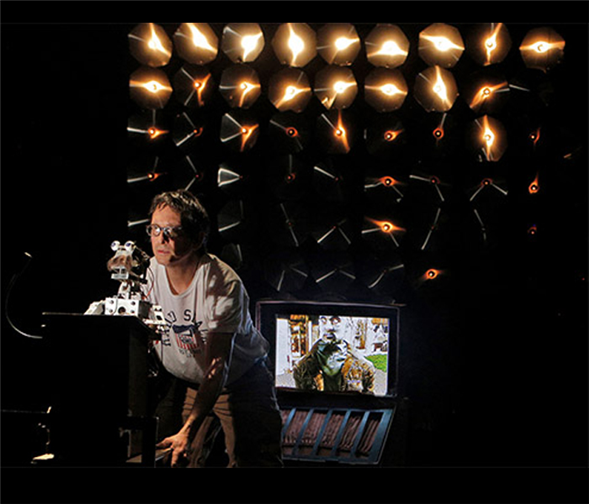Translate Page

Inside Joseph Silovsky's gadget theatre
---
Joseph Silovsky is concerned that he's not explaining things well.
"Am I being too technical?" he asks, after elaborating on how his robot Stanley used to move in response to an audio track on an iPod but now can move in response to live voices.
This is all part of Send for the Million Men, a gadget/theatre hybrid which runs through Dec. 13 at HERE Arts Center. Stanley is a just the latest charming robot created by Silovsky, a self-taught tinkerer who specializes in fusing high- and lo-fi machines with semi-solo documentary-esque theatre.
Send for the Million Men primarily centers on the controversial executions of 1920s anarchists Nicola Sacco and Bartolomeo Vanzetti. Silovsky happened upon their story in an article at the library, and when he asked his friends about the pair, who were convicted of a murder tied to the armed robbery of a Massachusetts shoe factory, he found people either knew everything about them or nothing about them. He traveled to their home towns in Italy and read "three feet of shelf space" of books about the duo. He immediately saw their saga as a piece of theatre, but he didn't quite know how it would work.
"It's a layered story," he explains. "There's this conventional trial story, but then there's the larger political and geopolitical end of things. Then there's the private story about the two men, and I wasn't sure how to approach it, as well as the fact that I don't do conventional theatre."
That's for sure. A fixture of the downtown scene, Silovsky has been performing with his machines since 1990 and has worked with companies like St. Ann's Warehouse, P.S. 122, and Dixon Place.
So when he works, which comes first, the machines or the script? "I'm kind of doing two things concurrently," he explains. "I'll write something up, but inevitably it gets edited severely through working with the object and seeing how the relationship between the text and the object develop and what direction it wants to go."
And Stanley, who plays the part of Vanzetti in the piece (complete with a mustache made from Silovsky's own hair), isn't the only machine dictating the narrative. For example, in a scene when the cops are searching for evidence of the murder, there are clues scattered across Washington D.C. Using an overhead projector, Silovsky projects the map of the city on suitcases scattered across the stage, and he creates a literal search for the evidence, as he walks around the stage looking for where his handheld lens will bring an object on the projector into view. "The actions of presenting it to the audiences are reflecting the physical actions of the actual event as well," he says.
The show goes beyond just Sacco and Vanzetti, however. Silovsky connects their story to that of the Tulsa Race Riots, which happened around the same time in the 1920s. (Silovsky grew up in Oklahoma City and didn't learn about the riots in school.) He also brings in his own personal story, particularly the fact that his mother survived the Oklahoma City bombings in 1995, the same time he was learning about Sacco and Vanzetti.
"I'm kind of sitting on this fence between a bomber almost killing my mother, but also sympathizing with these people who are associated with bombers. That moral grayness is important to me," he says. "My way of telling a story is never a pure narrative of the events. I really am telling a story of me telling a story. I'm not just teaching you a lesson about this historic event. I'm connecting it to now and to me, and I'm also trying to connect it to our world and what's going on in this world as well."
The night Million Men began performances was the same night many protests happened across New York City in response to the decision not to indict the officer who killed Eric Garner. "The fact that all the protests were going on that night was poignant for me," says Silovsky. "It's not directly related, but there is this sense of the conflict between society wanting security and society wanting freedom."
---
Suzy Evans is a writer and editor based in New York City
Photo of Joseph Silovsky (and robots) by Cory Weaver